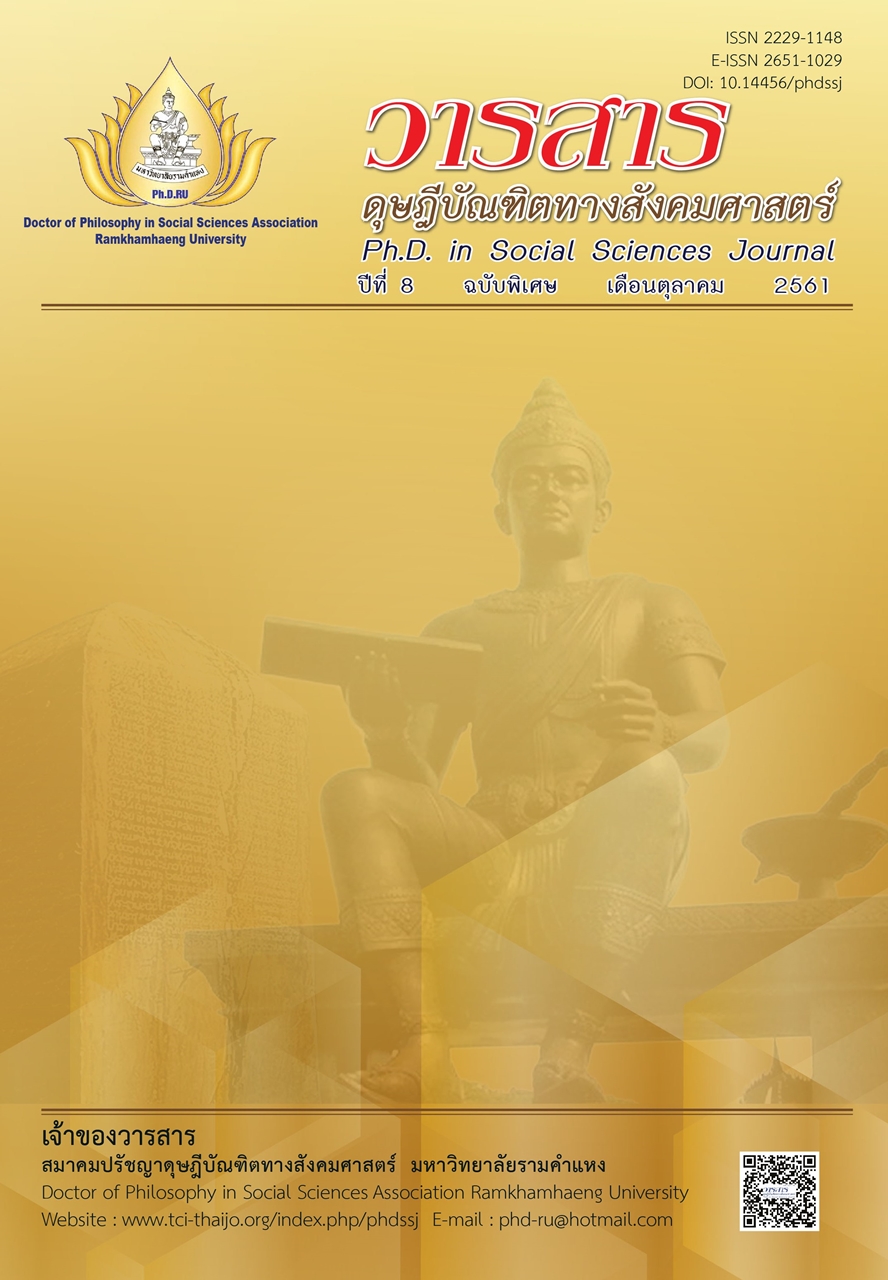สิทธิประโยชน์ทางภาษีกับผลตอบแทนที่เป็นตัวเงินของธุรกิจผลิตชิ้นส่วนยานยนต์ที่ได้รับการส่งเสริมการลงทุนจากสำนักงานคณะกรรมการส่งเสริมการลงทุน
Main Article Content
บทคัดย่อ
การวิจัยนี้มีวัตถุประสงค์ (1) เพื่อศึกษาถึงผลตอบแทนที่เป็นตัวเงินของธุรกิจผลิตชิ้นส่วนยานยนต์ที่ได้รับการส่งเสริมการลงทุนจากบีโอไอ (2) เพื่อศึกษาถึงผลตอบแทนที่เป็นตัวเงินของภาครัฐที่ให้การส่งเสริมการลงทุนในธุรกิจผลิตชิ้นส่วนยานยนต์ (3) เพื่อศึกษาอิทธิพลของสิทธิประโยชน์ทางภาษีของธุรกิจที่ได้รับการส่งเสริมการลงทุนจากบีโอไอที่มีต่อผลตอบแทนที่เป็นตัวเงินของภาคเอกชนและภาครัฐ (4) เพื่อศึกษาผลได้ผลเสียของการให้สิทธิประโยชน์ทางภาษีของบีโอไอแก่ธุรกิจ เป็นการวิจัยเชิงปริมาณและเชิงคุณภาพ กลุ่มตัวอย่าง คือ บริษัทผู้ผลิตชิ้นส่วนยานยนต์ที่ได้รับการส่งเสริมการลงทุนจากบีโอไอ จำนวน 52 บริษัท ข้อมูลสำหรับการศึกษาได้จากงบการเงินของบริษัท ในรอบระยะเวลาบัญชี ปี พ.ศ. 2555-2559 ใช้สถิติ ร้อยละ ค่าเฉลี่ย และการวิเคราะห์ถดถอยพหุ
ผลการวิจัย สรุปได้ดังนี้
ผลตอบแทนที่เป็นตัวเงินของภาคเอกชน พบว่า มีมูลค่าปัจจุบันสุทธิ 36,448,331,511.41 บาท มีค่าเป็นบวก โดยลงทุน 1 บาท ได้รับผลตอบแทน 1.20 บาท อัตราผลตอบแทนภายใน 19.72% สูงกว่าอัตราดอกเบี้ยเงินกู้เฉลี่ย MLR และอัตราผลตอบแทนภายใน -7.00% ซึ่งตํ่ากว่าอัตราดอกเบี้ยพันธบัตรรัฐบาล
ผลการทดสอบสมมติฐาน พบว่า การยกเว้นภาษีเงินได้นิติบุคคล การยกเว้นภาษีจากส่วนสูญเสียจากการผลิตที่ลดลงมีอิทธิพลเชิงบวกต่อผลตอบแทนที่เป็นตัวเงินของภาคเอกชน และการยกเว้นภาษีรายได้จากการขายเศษซากมีอิทธิพลเชิงลบต่อผลตอบแทนที่เป็นตัวเงินของภาคเอกชน และการยกเว้นภาษีจากส่วนสูญเสียจากการผลิตที่ลดลงมีอิทธิพลเชิงบวกต่อผลตอบแทนที่เป็นตัวเงินของภาครัฐ
สิทธิประโยชน์ทางภาษีที่ทำให้ธุรกิจได้รับผลตอบแทนที่เป็นตัวเงินมากที่สุด คือ การยกเว้นภาษีเงินได้นิติบุคคล ส่วนสิทธิประโยชน์ทางภาษีในด้านการลดหย่อนและการหักรายจ่ายได้เป็น 2 เท่า นั้นไม่มีผลต่อผลตอบแทนที่เป็นตัวเงินของธุรกิจ และบีโอไอควรเพิ่มการให้สิทธิประโยชน์ทางภาษีด้านการยกเว้นภาษีจากส่วนสูญเสียจากการผลิตที่ลดลง เพราะจะทำให้ภาคเอกชนได้รับผลตอบแทนที่เป็นตัวเงิน และจะส่งผลให้ภาครัฐได้รับประโยชน์จากการยกเว้นภาษีจากส่วนสูญเสียจากการผลิตที่ลดลง
Article Details
บทความวิชาการ บทความวิจัย และบทวิจารณ์หนังสือในวารสารดุษฎีบัณฑิตทางสังคมศาสตร์ เป็นความคิดเห็นของผู้เขียน มิใช่ของคณะผู้จัดทำ และมิใช่ความรับผิดชอบของสมาคมปรัชญาดุษฎีบัณฑิตทางสังคมศาสตร์ มหาวิทยาลัยรามคำแหง (กรณีการทำวิจัยในมนุษย์ ผู้วิจัยต้องผ่านการอบรมจริยธรรมการวิจัยในมนุษย์ และนำหลักฐานมาแสดง)
เอกสารอ้างอิง
Bierman, H., & Smidt, S. (2007). The capital budgeting decision: Economic analysis of investment projects (9th ed.). New York: Routledge.
Boardman, A. E., Vining, A. R., Greenberg, D. H., & Weimer, D. L. (1996). Cost-benefit analysis concepts and practice. Upper Saddle River, NJ: Prentice Hall.
Board of Investment (BOI.) (2017). Company database. Retrieved May 31, 2017, from https://www.boi.go.th/index.php?page=form_promoted_companies [In Thai]
Burhan, A. H., & Rahmanti, W. (2012). The impact of sustainability reporting on company performance. Journal of Economics, Business, and Accountancy Ventura, 15(2), 257-272.
Collins, C. N. (2008). Environmental responsibility and firm performance: Evidence from Nigeria. International Journal of Social, Behavioral, Educational, Economic, Business and Industrial Engineering, 2(10), 1055-1062.
Cooper, D. R., & Sclindler, P. S. (2001). Business research methods (7th ed.). Singapore: McGraw-Hill.
BDA Group and McLennan Magasanik Associates (2003). The potential of market-based instruments to better manage Australia’s waste streams. Retrieved May 31, 2017, from https://www.deh.gov.au/settlements publications/waste/ mbi/study-2003/pubs/study.pdf
Fabozzi, F. J. (2003). Financial management and analysis. Hoboken, NJ: John Wiley & Sons.
Huang, L. H., Hsiao, H. C., & Wang, J. C. (2012). The efficiency performance of Taiwanese enterprises in China: Tax incentive perspective. African Journal of Business Management, 6(12), 4432-4444.
Laoonua, Y., Techakanont, K., Kanitpong, K., Angkasith, V., Boonsothonsatit, K., Ruangjirasak., Homklin, T., & Dokmaitayt, T. (2017). Policy research to raise green automotive industry in Thailand. Bangkok: Thailand Research Fund. [In Thai]
McAfee, R. P., & Johnson, J. S. (2006) Introduction to economic analysis. Pasadena, CA: California Institute of Technology.
Meenapan, H. (2006). Principles of project analysis: Theories and practices for feasibility studies. Bangkok: Chulalongkorn University Press. [In Thai]
Morisset, J., & Pirnia, N. (2000). How tax policy and incentives affect foreign direct investment. Washington, DC: World Bank and International Finance Corporation.
Ngammeesri, L. (2018). Tax benefits, cost effectiveness, and investment worthiness in the hard disc drive and parts manufacturing businesses promoted by BOI with cost effectiveness and investment worthiness. Ph.D. in Social Sciences Journal, 8(1),2-16. [In Thai]
Organization for Economic Co-operation and Development. (2009). Governing regional development policy. Retrieved May 31, 2017, from https://www. oecd.org/publishing/corrigenda
Organization for Economic Co-operation and Development. (2011). Tax incentive for investment-background document. Retrieved May 31, 2017, from https://www.oecd.org/tax/tax-global
Pongpitak, S. (2016). BOI with the development of automotive industry. Investment Promotion Journal, 27(1), 26-35. [In Thai]
Sinjaru, T. (2010). Applied financial management with excel for investment and business plan development (3rd ed.). Nonthaburi: Nita Printing. [InThai]
Squire, L., & Herman, G. T. (1995). Economic analysis of projects (8th ed.). Baltimore, MD: Johns Hopkins University Press.
Sumleeon. (2015). Tax incentives on waste electrical and electronic equipment management in Thailand. Thammasat Business Law Journal, 5, 431-441. [In Thai]
Tessema, S. T. (2008). Competition to attract foreign direct investment through tax incentives as a threat for the realisation of socio-economic rights in Africa. Retrieved May 31, 2017, from https://repository.up.ac.za/bitstream/handle/2263/8064/tessema.pdf?sequence=1&isAllowed=y
Tsai, W. T., & Chou, Y. H. (2003). Government policies for encouraging industrial waste reuse and pollution prevention in Taiwan. Journal of Cleaner Production, 12(7), 725-736.
Tongyingsiri, P. (2001). Project planning and analysis. Bangkok: SE-ED. [In Thai]
Tuan Minh, Le. (2003). Analysis of tax and trade incentives for foreign direct investment: The case of Vietnam. Ph.D. dissertation, Harvard University, Massachusetts.
Tung, S., & Cho, S. (2001). Determinants of regional investment decisions in China: An econometric model of tax incentive policy. Journal of Quantitative Finance and Accounting, 17(2), 167-185.
Tularak, W. (2012). Capital mobility in automotive sector in Thailand. Bangkok: Asia Monitor Resource Centre. [In Thai]
United Nations Conference on Trade and Development. (2000). Tax incentives and foreign direct investment: A global survey. New York: United Nations.
VCC & WAIPA. (2010). Investment promotion agencies and sustainable FDI: Moving toward the fourth generation of investment promotion. Retrieved May 31, 2017, from https://ccsi.columbia.edu/files/2013/12/fdi.pdf
Wells, T. L., & Wint, A. G. (2000). Marketing a country: Promotion as a tool for attracting. Foreign Investment Advisory Service, Occasional Paper 13.
Wells, J. (2001). Petroleum and ethanol fuels: Tax incentives and related GAO work. Washington, DC: United States General Accounting.
Zolt, E. M. (2014). Tax incentives and tax base protection issues. Papers on selected topics in protecting the tax base of developing countries, draft paper no. 3.


